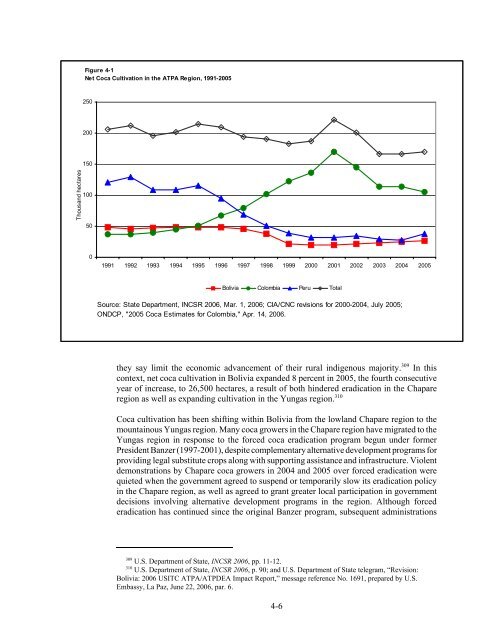Figure 4-1Net Coca Cultivation in <strong>the</strong> ATPA Region, 1991-2005250200Thousand hectares1501005001991 1992 1993 1994 1995 1996 1997 1998 1999 2000 2001 2002 2003 2004 2005Bolivia Colombia Peru TotalSource: State Department, INCSR 2006, Mar. 1, 2006; CIA/CNC revisions for 2000-2004, July 2005;ONDCP, "2005 Coca Estimates for Colombia," Apr. 14, 2006.<strong>the</strong>y say limit <strong>the</strong> economic advancement <strong>of</strong> <strong>the</strong>ir rural indigenous majority. 309 In thiscontext, net coca cultivation in Bolivia expanded 8 percent in 2005, <strong>the</strong> fourth consecutiveyear <strong>of</strong> increase, to 26,500 hectares, a result <strong>of</strong> both hindered eradication in <strong>the</strong> Chapareregion as well as expanding cultivation in <strong>the</strong> Yungas region. 310Coca cultivation has been shifting within Bolivia from <strong>the</strong> lowland Chapare region to <strong>the</strong>mountainous Yungas region. Many coca growers in <strong>the</strong> Chapare region have migrated to <strong>the</strong>Yungas region in response to <strong>the</strong> forced coca eradication program begun under formerPresident Banzer (1997-2001), despite complementary alternative development programs forproviding legal substitute crops along with supporting assistance and infrastructure. Violentdemonstrations by Chapare coca growers in 2004 and 2005 over forced eradication werequieted when <strong>the</strong> government agreed to suspend or temporarily slow its eradication policyin <strong>the</strong> Chapare region, as well as agreed to grant greater local participation in governmentdecisions involving alternative development programs in <strong>the</strong> region. Although forcederadication has continued since <strong>the</strong> original Banzer program, subsequent administrations309U.S. Department <strong>of</strong> State, INCSR 2006, pp. 11-12.310U.S. Department <strong>of</strong> State, INCSR 2006, p. 90; and U.S. Department <strong>of</strong> State telegram, “Revision:Bolivia: 2006 <strong>USITC</strong> ATPA/ATPDEA <strong>Impact</strong> Report,” message reference No. 1691, prepared by U.S.Embassy, La Paz, June 22, 2006, par. 6.4-6
since 2001 have maintained only “a holding action” with respect to coca eradication in <strong>the</strong>Chapare region. 311In <strong>the</strong> Yungas region, <strong>the</strong> Bolivian government has met with limited success in its ability tocurb increased coca cultivation. 312 In 2005, violent opposition by coca growers in <strong>the</strong> Yungasregion has prevented forced eradication <strong>the</strong>re by <strong>the</strong> government, and alternativedevelopment programs that were successful in <strong>the</strong> tropical lowlands <strong>of</strong> <strong>the</strong> Chapare regionhave proven difficult to adapt to <strong>the</strong> mountainous highlands <strong>of</strong> <strong>the</strong> Yungas region. As aconsequence, <strong>the</strong> U.S. Embassy reports that <strong>the</strong> Bolivian government has achieved noreduction in coca cultivation in <strong>the</strong> Yungas region to date. 313Alternative Development<strong>The</strong> USAID alternative development program in <strong>the</strong> Chapare region aims to streng<strong>the</strong>n <strong>the</strong>legal economy by improving <strong>the</strong> competitiveness <strong>of</strong> rural enterprises, building more effectivelocal institutions, and improving basic public services and social conditions. 314 Alternativedevelopment projects have been widely accepted in <strong>the</strong> Chapare region, including growinglegal crops <strong>of</strong> bananas, cocoa, c<strong>of</strong>fee, pineapple, and palm heart for export. 315 <strong>The</strong> alternativedevelopment program has significantly raised <strong>the</strong> income <strong>of</strong> farmers <strong>the</strong>re, 316 with net familyincome from legal production in <strong>the</strong> Chapare region rising from roughly $1,706 in 2000 toan estimated $2,667 in 2005. 317 More recently, alternative development programs in <strong>the</strong>Chapare region are moving toward a greater focus on local participation by municipalitiesin <strong>the</strong> development, implementation, and monitoring <strong>of</strong> <strong>the</strong>se programs. By <strong>the</strong> end <strong>of</strong> fiscalyear 2006, USAID alternative development support, coupled with <strong>the</strong> government’s AgrarianReform Institute, will help pass legal title for land to <strong>the</strong> farmers <strong>of</strong> approximately 30 percent<strong>of</strong> <strong>the</strong> 30,000 properties in <strong>the</strong> Chapare region in an effort to clarify legal land ownership,which is anticipated to encourage legal agricultural production ra<strong>the</strong>r than illicit cropcultivation. 318Alternative development in <strong>the</strong> Yungas region first aims to improve citizen participation inmunicipal government; to streng<strong>the</strong>n government oversight regulating land rights issues,such as land distribution from state-owned lands to private ownership; and to improve access311 U.S. Department <strong>of</strong> State, INCSR 2006, pp. 90-91.312U.S. Department <strong>of</strong> State telegram, “Bolivia’s Eradication Efforts: ‘Best Efforts’ May Not Be Enoughin <strong>the</strong> Future,” message reference No. 241, prepared by U.S. Embassy, La Paz, Jan. 25, 2005.313U.S. Department <strong>of</strong> State, INCSR 2006, pp. 90-91; U.S. Department <strong>of</strong> State telegram, “Bolivia’sEradication Efforts: ‘Best Efforts’ May Not Be Enough in <strong>the</strong> Future,” message reference No. 241, preparedby U.S. Embassy, La Paz, Jan. 25, 2005.314 U.S. Department <strong>of</strong> State, INCSR 2006, p. 90.315Ibid.; U.S. Department <strong>of</strong> State telegram, “Bananas Lead <strong>the</strong> Way for Sustaining a Licit Economy inBolivia’s Chapare,” message reference No. 2772, prepared by U.S. Embassy, La Paz, Sept. 13, 2005; U.S.Department <strong>of</strong> State telegram, “Chapare Road Blockades Exact Heavy Economic Loss,” message referenceNo. 902, prepared by U.S. Embassy, La Paz, Mar. 17, 2005. A number <strong>of</strong> alternative development productsthat receive trade preferences under ATPA also receive trade preferences under <strong>the</strong> GSP (e.g., palm hearts)or enter <strong>the</strong> United States unconditionally free <strong>of</strong> duty under MFN/NTR rates (e.g., bananas, c<strong>of</strong>fee).316U.S. Department <strong>of</strong> State, INCSR 2006, p. 90.317 U.S. Department <strong>of</strong> State, INCSR 2006, p. 92, and previous issues. In contrast, net family income in <strong>the</strong>Yungas region was estimated at $1,711 in 2005. GDP per capita income in Bolivia in 2005 wasapproximately $940. <strong>The</strong> USAID Chapare Alternative Development Program began in 1997, whereas <strong>the</strong>USAID Yungas Development Initiative began in 2000. Comparable figures for net family income in <strong>the</strong>Yungas region are not available for 2000.318 U.S. Department <strong>of</strong> State, INCSR 2006, p. 92.4-7
















